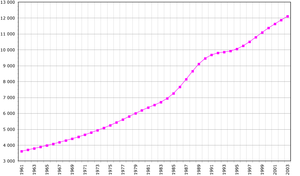- Demographics of Malawi
-
This article is about the demographic features of the population of Malawi, including population density, ethnicity, education level, health of the populace, economic status, religious affiliations and other aspects of the population.
Malawi derives its name from the Maravi, a Bantu people who came from the southern Congo about 600 years ago. On reaching the area north of Lake Malawi, the Maravi divided. One branch, the ancestors of the present-day Chewas, moved south to the west bank of the lake. The other, the ancestors of the Nyanjas, moved down the east bank to the southern part of the country.
By AD 1500, the two divisions of the tribe had established a kingdom stretching from north of the present-day city of Nkhotakota to the Zambezi River in the south, and from Lake Malawi in the east, to the Luangwa River in Zambia in the west.
Migrations and tribal conflicts precluded the formation of a cohesive Malawian society until the turn of the 20th century. In more recent years, ethnic and tribal distinctions have diminished. Regional distinctions and rivalries, however, persist. Despite some clear differences, no significant friction currently exists between tribal groups, and the concept of a Malawian nationality has begun to take hold. Predominantly a rural people, Malawians are generally conservative and traditionally nonviolent.
The Chewas constitute 90% of the population of the central region; the Nyanja tribe predominates in the south and the Tumbuka in the north. In addition, significant numbers of the Tongas live in the north; Ngonis--an offshoot of the Zulus who came from South Africa in the early 19th century—live in the lower northern and lower central regions; and the Yao, who are mostly Muslim, predominate in the Southern Region of the country and live in a wide band from Blantyre and Zomba north to Lake Malawi and east to the border with Mozambique. Bantus of other tribes came from Mozambique as refugees.
CIA World Factbook demographic statistics
The following demographic statistics are from the CIA World Factbook, unless otherwise indicated.
Population
- 10,385,849 (July 2000 est.)
- 13,931,831 (July 2008 est.)
Age structure
- 0-14 years: 45% (male 2,335,440; female 2,324,012)
- 15-64 years: 52% (male 2,671,580; female 2,766,560)
- 65 years and over: 3% (male 117,932; female 170,325) (2000 est.)
- 0-14 years: 45.4% (male 3,419,711/female 3,404,726)
- 15-64 years: 51.9% (male 3,889,065/female 3,915,309)
- 65 years and over: 2.7% (male 172,679/female 227,267) (2009 est.)
Population growth rate
2.763% (2011 est.)
Birth rate
40.85 births/1,000 population (2011 est.)
Death rate
13.22 deaths/1,000 population (2011 est.)
Net migration rate
0 migrant(s)/1,000 population (2011 est.)
Sex ratio
- at birth: 1.03 male(s)/female
- under 15 years: 1 male(s)/female
- 15-64 years: 0.97 male(s)/female
- 65 years and over: 0.69 male(s)/female
- total population: 0.97 male(s)/female (2000 est.)
Infant mortality rate
81.04 deaths/1,000 live births
Male: 85.11 deaths/1,000 live births
Female: 76.9 deaths/1,000 live births (2011 est.)Ratio of medical doctors to general population
1 Doctor/65,000 Malawians [1]
Life expectancy at birth
- total population: 51.70 years
- male: 50.93 years
- female: 52.48 years (2011 est.)
Total fertility rate
- 5.51 children born/woman (2010 est.)
Nationality
- noun: Malawian(s)
- adjective: Malawian
Ethnic groups
- Chewa people
- Nyanja
- Tumbuka
- Yao
- Lomwe
- Sena
- Tonga
- Ngoni
- Ngonde
Religions
Languages
English (official), Chichewa (official), other languages important regionally
Literacy
- definition: age 15 and over can read and write
- total population: 62.7%
- male: 76.1%
- female: 49.8% (2003 est.)
See also
References
- ^ von Bothmer, Eleanore (2009). "Global lack of medical doctors". Development and Cooperation (Frankfurt am Main: Societäts-Verlag) 36 (3): 94. http://www.inwent.org/ez/articles/087353/index.en.shtml.
Demographics of Africa Sovereign
states- Algeria
- Angola
- Benin
- Botswana
- Burkina Faso
- Burundi
- Cameroon
- Cape Verde
- Central African Republic
- Chad
- Comoros
- Democratic Republic of the Congo
- Republic of the Congo
- Côte d'Ivoire (Ivory Coast)
- Djibouti
- Egypt
- Equatorial Guinea
- Eritrea
- Ethiopia
- Gabon
- The Gambia
- Ghana
- Guinea
- Guinea-Bissau
- Kenya
- Lesotho
- Liberia
- Libya
- Madagascar
- Malawi
- Mali
- Mauritania
- Mauritius
- Morocco
- Mozambique
- Namibia
- Niger
- Nigeria
- Rwanda
- São Tomé and Príncipe
- Senegal
- Seychelles
- Sierra Leone
- Somalia
- South Africa
- South Sudan
- Sudan
- Swaziland
- Tanzania
- Togo
- Tunisia
- Uganda
- Zambia
- Zimbabwe
States with limited
recognition- Sahrawi Arab Democratic Republic
- Somaliland
Dependencies and
other territories- Canary Islands / Ceuta / Melilla / Plazas de soberanía (Spain)
- Madeira (Portugal)
- Mayotte / Réunion (France)
- Saint Helena / Ascension Island / Tristan da Cunha (United Kingdom)
- Western Sahara
Categories:- Demographics by country
- Malawian society
Wikimedia Foundation. 2010.

